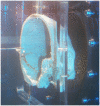High power transcranial beam steering for ultrasonic brain therapy
- PMID: 12974575
- PMCID: PMC3002099
- DOI: 10.1088/0031-9155/48/16/301
High power transcranial beam steering for ultrasonic brain therapy
Abstract
A sparse phased array is specially designed for non-invasive ultrasound transskull brain therapy. The array is made of 200 single elements corresponding to a new generation of high power transducers developed in collaboration with Imasonic (Besançon, France). Each element has a surface of 0.5 cm2 and works at 0.9 MHz central frequency with a maximum 20 W cm(-2) intensity on the transducer surface. In order to optimize the steering capabilities of the array, several transducer distributions on a spherical surface are simulated: hexagonal, annular and quasi-random distributions. Using a quasi-random distribution significantly reduces the grating lobes. Furthermore, the simulations show the capability of the quasi-random array to electronically move the focal spot in the vicinity of the geometrical focus (up to +/- 15 mm). Based on the simulation study, the array is constructed and tested. The skull aberrations are corrected by using a time reversal mirror with amplitude correction achieved thanks to an implantable hydrophone, and a sharp focus is obtained through a human skull. Several lesions are induced in fresh liver and brain samples through human skulls, demonstrating the accuracy and the steering capabilities of the system.
Figures












Similar articles
-
A numerical study of transcranial focused ultrasound beam propagation at low frequency.Phys Med Biol. 2005 Apr 21;50(8):1821-36. doi: 10.1088/0031-9155/50/8/013. Epub 2005 Apr 6. Phys Med Biol. 2005. PMID: 15815098
-
Micro-receiver guided transcranial beam steering.IEEE Trans Ultrason Ferroelectr Freq Control. 2002 Apr;49(4):447-53. doi: 10.1109/58.996562. IEEE Trans Ultrason Ferroelectr Freq Control. 2002. PMID: 11989700
-
A 63 element 1.75 dimensional ultrasound phased array for the treatment of benign prostatic hyperplasia.Biomed Eng Online. 2005 Jun 17;4:39. doi: 10.1186/1475-925X-4-39. Biomed Eng Online. 2005. PMID: 15963237 Free PMC article.
-
[High-intensity focused ultrasound transducer].Sheng Wu Yi Xue Gong Cheng Xue Za Zhi. 2009 Jun;26(3):667-70. Sheng Wu Yi Xue Gong Cheng Xue Za Zhi. 2009. PMID: 19634694 Review. Chinese.
-
Compensating for bone interfaces and respiratory motion in high-intensity focused ultrasound.Int J Hyperthermia. 2007 Mar;23(2):141-51. doi: 10.1080/02656730701209996. Int J Hyperthermia. 2007. PMID: 17578338 Review.
Cited by
-
Magnetic resonance-guided high-intensity focused ultrasound (MR-HIFU) ablation of liver tumours.Cancer Imaging. 2012 Sep 28;12(2):387-94. doi: 10.1102/1470-7330.2012.9038. Cancer Imaging. 2012. PMID: 23022541 Free PMC article. Review.
-
Transcranial ultrasonic therapy based on time reversal of acoustically induced cavitation bubble signature.IEEE Trans Biomed Eng. 2010 Jan;57(1):134-44. doi: 10.1109/TBME.2009.2031816. Epub 2009 Sep 18. IEEE Trans Biomed Eng. 2010. PMID: 19770084 Free PMC article.
-
Ultrasonic Neuromodulation Causes Widespread Cortical Activation via an Indirect Auditory Mechanism.Neuron. 2018 Jun 6;98(5):1031-1041.e5. doi: 10.1016/j.neuron.2018.05.009. Epub 2018 May 24. Neuron. 2018. PMID: 29804920 Free PMC article.
-
Focusing of high-intensity ultrasound through the rib cage using a therapeutic random phased array.Ultrasound Med Biol. 2010 Jun;36(6):888-906. doi: 10.1016/j.ultrasmedbio.2010.03.007. Ultrasound Med Biol. 2010. PMID: 20510186 Free PMC article.
-
Emerging non-cancer applications of therapeutic ultrasound.Int J Hyperthermia. 2015 May;31(3):310-8. doi: 10.3109/02656736.2015.1004375. Epub 2015 Mar 20. Int J Hyperthermia. 2015. PMID: 25792225 Free PMC article. Review.
References
-
- Aubry J-F, Tanter M, Pernot M, Thomas J-L, Fink M. Experimental demonstration of non invasive transskull adaptive focusing based on prior CT scans. J Acoust Soc Am. 2003;113(1):85–93. - PubMed
-
- Cassereau D, Guyomar D. Computation of the impulse diffraction of any obstacle by impulse ray modelling – Prediction of the signals distortions. J Acoust Soc Am. 1988;84(4):1504–1516.
-
- Chapelon J-Y, Cathignol D, Cain C, Ebbini E, Kluiwstra J, Sapozhnikov OA, Fleury G, Berriet R, Chupin L, Guey J-L. New piezoelectric transducers for therapeutic ultrasound. Ultrasound Med Biol. 2000;26(1):153–159. - PubMed
-
- Clement GT, White JP, Hynynen K. Investigation of a large area phased array for focused ultrasound surgery through the skull. Phys Med Biol. 2000;45:1071–1083. - PubMed
Publication types
MeSH terms
LinkOut - more resources
Full Text Sources
Other Literature Sources
Medical
